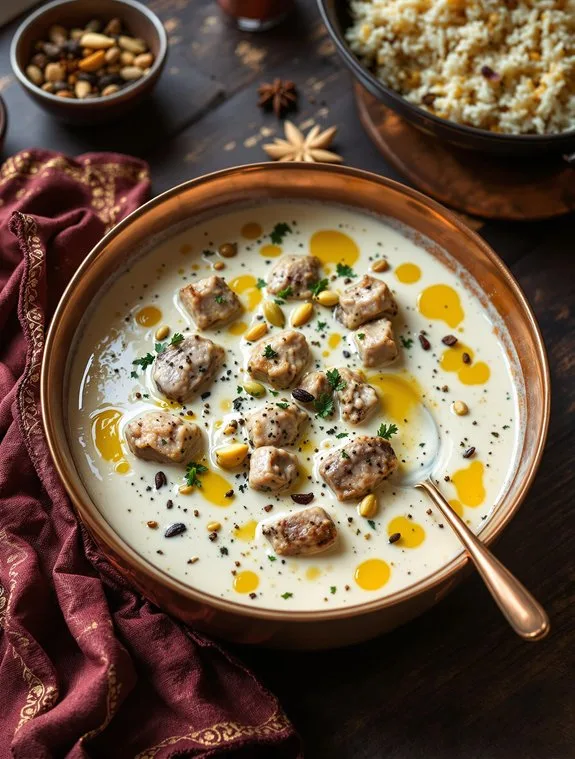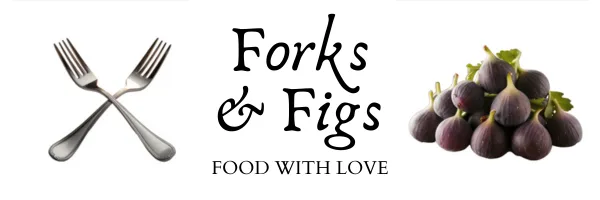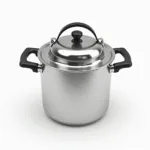Rich & Creamy Kashmiri Yakhni: A Traditional Recipe

I’ll be honest with you – I’m slightly obsessed with dishes that make my kitchen smell like a spice market, and Kashmiri Yakhni does exactly that. This isn’t your typical curry though. No onions, no garlic, just tender mutton swimming in the most gorgeous yogurt-based gravy that’s practically velvet in a bowl. The whole spices do all the heavy lifting here, creating something that feels both exotic and oddly familiar, like comfort food from someone else’s childhood.
Why You’ll Love this Rich & Creamy Kashmiri Yakhni
When you’re craving something that feels like a warm hug from your grandmother’s kitchen, Kashmiri Yakhni delivers that soul-satisfying comfort in spades. This isn’t your average curry—it’s pure elegance in a bowl.
What makes me obsessed with this dish? The silky, cream-colored gravy that coats tender mutton like liquid velvet. No garlic or onions here, which might sound crazy, but trust me on this one.
The yogurt reduction technique creates magic, transforming tangy dairy into something impossibly rich.
Those aromatic whole spices? They’ll make your kitchen smell like heaven opened its doors.
What Ingredients are in Rich & Creamy Kashmiri Yakhni?
The beauty of Kashmiri Yakhni lies in its deceptively simple ingredient list that creates something absolutely extraordinary. You won’t find the usual suspects like onions, garlic, or tomatoes here—this dish proves that sometimes less really is more.
What you’ll need is tender mutton, creamy yogurt, and a carefully chosen ensemble of whole spices that work together like a well-rehearsed orchestra. Each ingredient has a specific job, and honestly, there are no understudies in this cast.
For the Mutton:
- 1.5 kg mutton (chest and shoulder pieces work best)
- 500 ml water for cooking
For the Spice Foundation:
- 5 black cardamom pods, cracked open
- 9 green cardamom pods, cracked open
- 4 bay leaves
- 5 whole cloves
- Pinch of asafoetida (hing)
For the Creamy Base:
- 500 g plain yogurt, whisked smooth
- 2 tbsp ghee
For the Flavor Profile:
- 3 tsp fennel powder
- 1.5 tsp ginger powder
- 2 tsp salt, divided
- ½ tsp dried crushed mint
- ½ tsp black cumin (shahi jeera)
Choosing Your Mutton
The cut of meat makes all the difference here, and I’m not just being dramatic. Chest and shoulder pieces have that perfect balance of meat and fat that becomes melt-in-your-mouth tender after pressure cooking.
Don’t even think about using lean cuts—you’ll end up with something that tastes like expensive cardboard.
The Yogurt Situation
Your yogurt choice is vital, so please don’t grab the first container you see. Full-fat, plain yogurt works best because it won’t curdle as easily during the reduction process.
Greek yogurt is too thick and can get weird, while low-fat versions just don’t have the richness this dish deserves.
Spice Notes That Matter
Black cardamom and green cardamom might seem redundant, but they’re completely different characters. The black ones bring that smoky, earthy depth while the green ones add bright, floral notes.
And that black cumin, or shahi jeera, isn’t regular cumin—it’s smaller, darker, and has this almost nutty quality that regular cumin just can’t match.
How to Make this Rich & Creamy Kashmiri Yakhni

Making Kashmiri Yakhni is like conducting a delicate dance between pressure cooking and yogurt reduction, and honestly, timing is everything here. The good news is that most of this happens simultaneously, so you’re not standing around waiting for one thing to finish before starting another.
Getting the Mutton Tender
Start by getting that 1.5 kg of mutton into your pressure cooker with 500 ml of water, 5 cracked black cardamom pods, 4 bay leaves, and half of your salt. The key word here is “cracked” for those cardamom pods—you want to bruise them just enough to release their oils without letting all the seeds escape into your broth.
Pressure cook until the mutton is fork-tender, which usually takes about 45 minutes depending on your cooker. You want meat that practically falls apart when you look at it wrong.
While that’s happening, you’ll be working on what I consider the trickiest part of this entire recipe.
The Yogurt Reduction Challenge
This is where things get real, and I’m not going to sugarcoat it—reducing 500 g of whisked yogurt takes patience and constant attention.
Pour that yogurt into a heavy-bottomed pan, add 3 tsp fennel powder, 1.5 tsp ginger powder, and the remaining salt. Now comes the part that separates the committed from the casual: you need to stir this constantly over medium heat.
I mean constantly. The moment you think, “Oh, I can just check my phone for a second,” is exactly when your yogurt decides to curdle into something that looks like cottage cheese had a bad day.
Stir until the yogurt reduces by half, which takes about 20-25 minutes of your undivided attention.
Bringing It All Together
Once your mutton is tender and your yogurt is properly reduced, add that silky yogurt mixture to the mutton and its cooking liquid. Let this simmer for exactly 4 minutes while stirring gently—you’re not making scrambled eggs here, so easy does it.
Now add 2 tbsp of ghee along with 9 cracked green cardamom pods, 5 whole cloves, and a pinch of asafoetida. This is where the magic really happens, and you’ll smell exactly what I mean.
Keep cooking until the gravy thickens enough to coat the back of a spoon.
The Final Flourish
Right before you remove the pot from heat, stir in ½ tsp each of dried crushed mint and black cumin. These go in last because their flavors are delicate and you don’t want to cook them into submission.
One gentle stir to distribute everything evenly, then remove from heat immediately.
The finished yakhni should have this gorgeous, creamy consistency that’s neither too thick nor too thin—think somewhere between heavy cream and a light gravy.
If yours looks more like soup, you probably didn’t reduce the yogurt enough, and if it’s too thick, a splash of the cooking liquid will fix that right up.
Rich & Creamy Kashmiri Yakhni Substitutions and Variations
Look, I get it—not everyone has a pantry stocked with shahi jeera and fennel powder, and sometimes you’re staring at chicken thighs instead of mutton, wondering if this whole Kashmiri Yakhni thing is even possible.
Here’s the truth: you can absolutely swap mutton for chicken, lamb, or even goat. Just adjust your cooking time accordingly.
No fennel powder? Ground coriander works beautifully. Missing shahi jeera? Regular cumin will do the trick, though you’ll lose some of that distinctive aromatic punch.
For vegetarians, cauliflower or paneer creates surprisingly satisfying variations that honor the original’s creamy, spiced essence.
What to Serve with Rich & Creamy Kashmiri Yakhni
Now that you’ve mastered this aromatic masterpiece, what exactly pairs with something this rich and complex? I always reach for steamed basmati rice first—it’s like a blank canvas that soaks up every drop of that creamy, spiced gravy.
Warm naan or chapati work beautifully too, giving you something to scoop with.
For vegetables, I’ll add simple sautéed greens or roasted cauliflower. They won’t compete with the yakhni’s delicate flavors.
A cooling cucumber raita balances the warmth perfectly. Trust me, you’ll want something invigorating alongside this indulgent dish.
Final Thoughts
When you close the pot on this yakhni, you’re not just finishing a recipe—you’re completing a tradition that’s been passed down through generations of Kashmiri kitchens.
This isn’t complicated cooking, but it’s precise cooking. Every stir of that yogurt matters. Every crack of those cardamom pods releases something special.
I won’t pretend this dish will change your life, but it might change your dinner plans. The creamy, aromatic broth paired with tender mutton creates something that feels both exotic and comforting.
Take your time with this one.
Good yakhni, like good stories, can’t be rushed.

Kashmiri Yakhni
Ingredients
- 1.5 kg mutton chest and shoulder, cut into pieces
- 500 ml water
- 5 black cardamom pods cracked
- 4 bay leaves
- 500 g plain yogurt whisked
- 3 tsp fennel powder
- 1.5 tsp ginger powder
- 2 tsp salt divided
- 2 tbsp ghee
- 9 green cardamom pods cracked
- 5 cloves
- Pinch of asafoetida hing
- ½ tsp dried crushed mint
- ½ tsp black cumin shahi jeera
Instructions
- Add mutton pieces to pressure cooker with water, black cardamom pods, bay leaves, and 1 tsp salt. Cook until tender (about 20-25 minutes).
- While mutton cooks, place whisked yogurt in a heavy-bottomed pan with fennel powder, ginger powder, and remaining salt. Cook over medium heat, stirring continuously to prevent curdling, until volume reduces by half.
- Add the reduced yogurt mixture to the cooked mutton and broth. Simmer for 4 minutes, stirring gently.
- Add ghee, green cardamom pods, cloves, and asafoetida. Continue cooking until gravy reaches desired thickness.
- Stir in dried mint and black cumin, then remove from heat immediately.
Notes
Nutrition
Frequently Asked Questions
Can I Make Kashmiri Yakhni Without a Pressure Cooker?
Yes, I can make Kashmiri yakhni without a pressure cooker. I’ll cook the mutton in a heavy-bottomed pot with water and spices, simmering covered for 1-2 hours until tender.
How Long Can Leftover Kashmiri Yakhni Be Stored in the Refrigerator?
I’d recommend storing leftover Kashmiri yakhni in the refrigerator for up to three days maximum. I’ll make sure you reheat it thoroughly before serving, and you’ll notice the flavors actually develop beautifully overnight.
What’s the Difference Between Kashmiri Yakhni and Regular Mutton Curry?
I’d say the main difference is that Kashmiri yakhni uses yogurt as its base instead of tomatoes or onions, creating a white, delicate gravy with aromatic spices like fennel and cardamom.
Can I Freeze Kashmiri Yakhni for Meal Prep?
You can freeze Kashmiri yakhni for up to three months. I’d recommend freezing it in portion-sized containers. When reheating, thaw overnight and gently warm while stirring to prevent the yogurt from separating.
Why Does My Yogurt Curdle When Making Kashmiri Yakhni?
Your yogurt’s curdling because you’re not stirring constantly or adding it too quickly to hot broth. I always whisk yogurt thoroughly, reduce it slowly over medium heat, and stir continuously to prevent separation.




